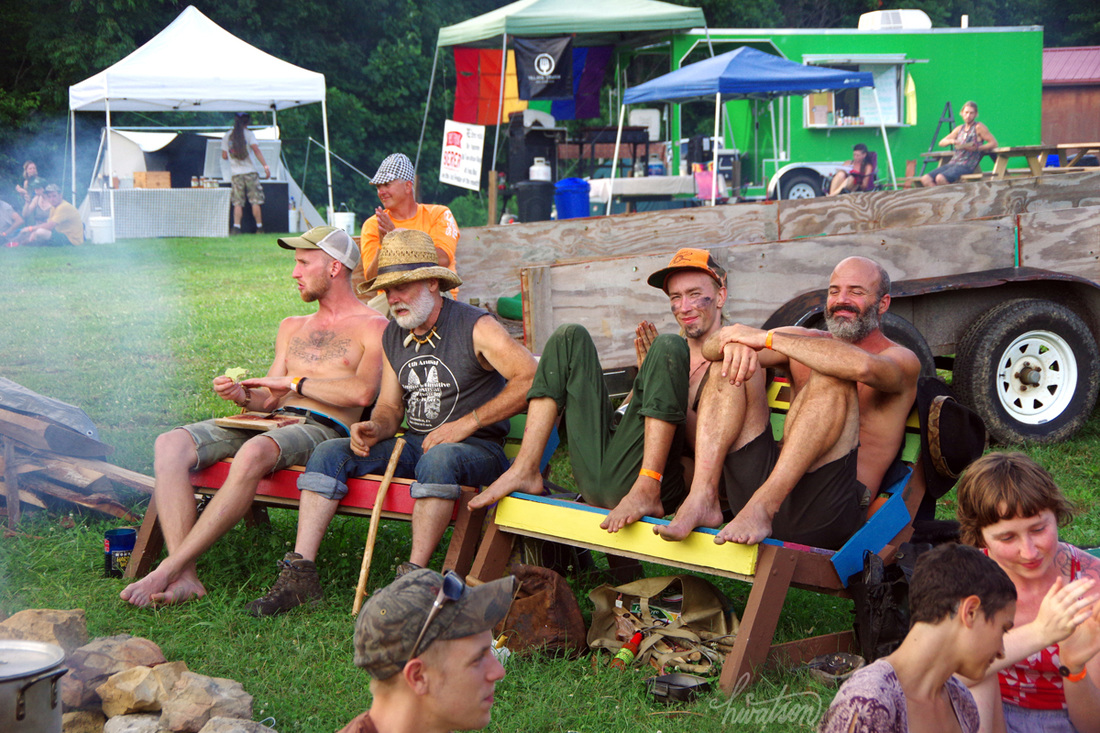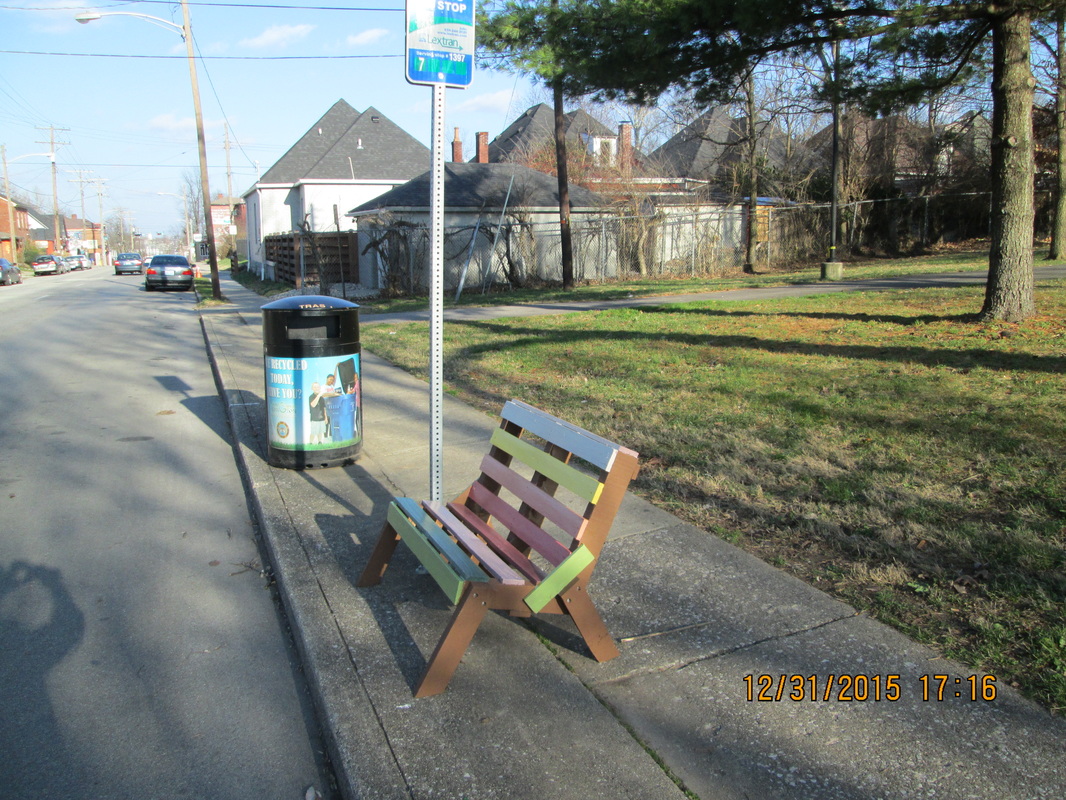|
At the 2015 Whippoorwill Festival – Skills for Earth-Friendly Living, a factory worker named Tony Jackson from Richmond, Kentucky led a workshop in which he demonstrated how to make simple furniture out of discarded wooden shipping pallets. Tony has built tables, chairs, benches and coffee tables from the free pallets that can be found behind almost any store or warehouse. I thought this was a great example of the old Appalachian traditions of thrift and making-do with what’s available – perfect for the theme of Whippoorwill - and I loved having him teach at the festival.
At Whippoorwill Tony built an imaginative loveseat in about 30 minutes. It wasn’t the most comfortable thing, but it was cool-looking, sturdy and certainly functional. It looked great around the fire circle at the festival site. I started learning more about pallets. According to Pallet Enterprise Magazine, “The pallet industry has been by far the largest consumer of hardwoods for the past 30 years.” In 2006, over 7 billion board feet of hardwoods were used to make pallets, according to researchers at Virginia Tech. Our Appalachian hardwood forests are being cut down to make pallets! Some pallets are used only one time before being discarded into a dumpster at a construction site. Many used pallets are ground into mulch. This seems to be a very poor use of our natural resources. Some would say it’s incredibly wasteful. Intrigued, I started trying to build my own pallet furniture in the garage. I quickly found enough pallets to build a small village, but I didn’t have the right wood-working tools. A lot of trial and error and pondering was required to build anything without getting hurt. Pallets use special adhesive-coated spiral nails to hold the deck boards to the runners. These nails cannot be extracted, and the boards usually cannot be pried or hammered loose without splitting the wood. It’s very dangerous to work with pallets because of these nails. I bought safety goggles, ear plugs, and steel-toed boots, plus about $2000 worth of hardware and wood-working equipment. I began using a brick mason’s chisel and a mallet to open up a small gap between the deck board and the runner. Then I used a hack saw or a reciprocating power saw to cut the nails to remove the deck boards. Once I figured out this trick, I began building tables, Adirondack chairs, and park benches in my garage using my own designs – I didn’t want to copy someone else’s ideas from the internet. As I built more and more pieces, they filled the garage and began spilling out into the backyard. Patty was not happy. What I was going to do with all of these benches? First I donated some benches to Wiley’s Last Resort on top of Pine Mountain in Kentucky to put around the campfire circles for their Supermoon Music Festival. Then I started placing them anonymously along walking trails in our city parks and at bus stops, to give people a place to sit while they are waiting for the bus. The wooden benches did not look right on our city streets, so I painted the slats using bright colors. People came up to me while I was painting them on the street and thanked me profusely, which made me feel good. And they looked pretty cool: a bright splash of color on the sidewalk. Street art! The bus company, Lextran finally sent out a press release asking about the benches. Channel 18 broadcast a story about the “Secret Samaritan,” and our local newspaper, the Lexington Herald-Leader, ran a nice story entitled “Who’s Leaving Colorful Benches at Bus Stops? Lextran Doesn’t Know” on page 3 with a lot of pictures. This story got a ton of responses on social media from bus riders who supported what I was doing, and who wanted to know why the bus company didn’t have benches at all of their bus stops. The bus company got pretty embarrassed, and so they decided the best thing to do was to remove all of my benches and hide them in their warehouse. I went down to the bus company headquarters with my 89-year old mother-in-law, and the bus company executives explained to me about sidewalk permits and other regulations that they were required to abide by. But instead of working to get the necessary permits, they asked me to sign some legal mumbo-jumbo promising not to sue them if someone got hurt sitting on one of my benches. My mother-in-law gave them down-the-road about it. “He was doing a nice thing … why do you have to take them away? He wasn’t asking for any money … and the people, the elderly, they need a place to sit.” I watched with amusement as the faces of the bus company executives turned ashen: You just can’t argue with an 89-year old lady. I am building lots more benches for the 2016 Whippoorwill Festival, which will be at a campground called Lago Linda in Kentucky’s Red River Gorge, which is fairly close to West Virginia. I am making more benches for people’s gardens, cabins and backyards, and memorial benches with a brass plaque in honor of people who have passed away. I have been building benches at street fairs and festivals and talking to people about ways they can safely use pallets for their own projects. I was feeling pretty good about my little enterprise until I recently met a man at the Huntington West Virginia Sustainability Fair. He came up to my booth and looked at my pallet benches, and then he said he had built pallet benches too. I asked him how long he had been doing it, and he said “Oh, about 15 years – I’ve built thousands of them!” For more information and to see pictures, go to the Kentucky Pallet Artist page on Facebook https://www.facebook.com/KYPalletArtist/
0 Comments
Your comment will be posted after it is approved.
Leave a Reply. |
AuthorDave Cooper is Founder of the Whippoorwill Festival Archives |



 RSS Feed
RSS Feed
